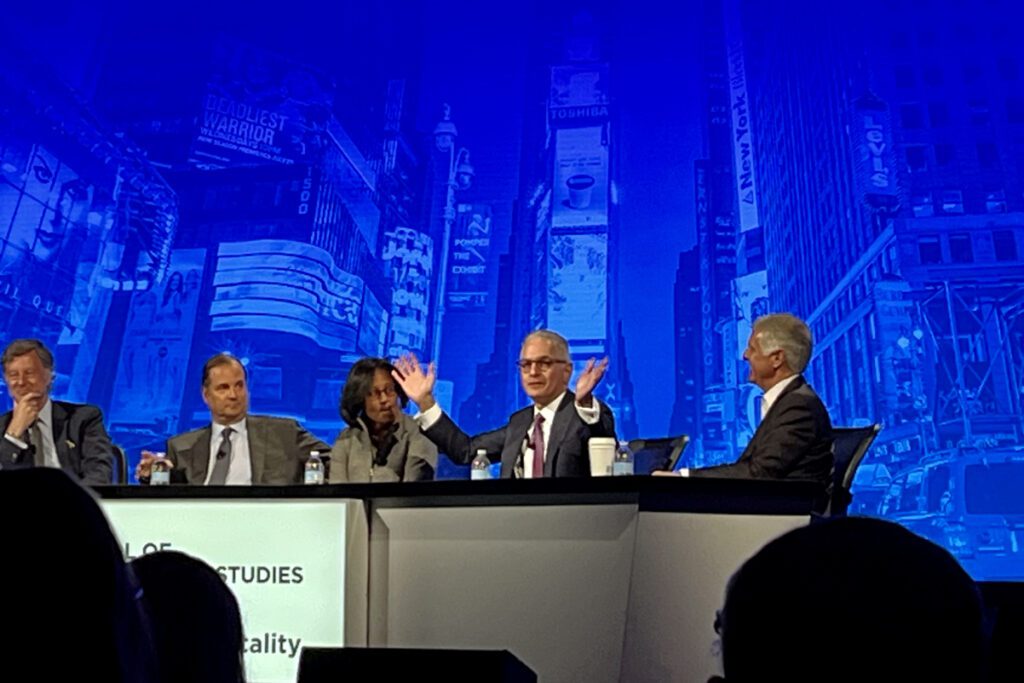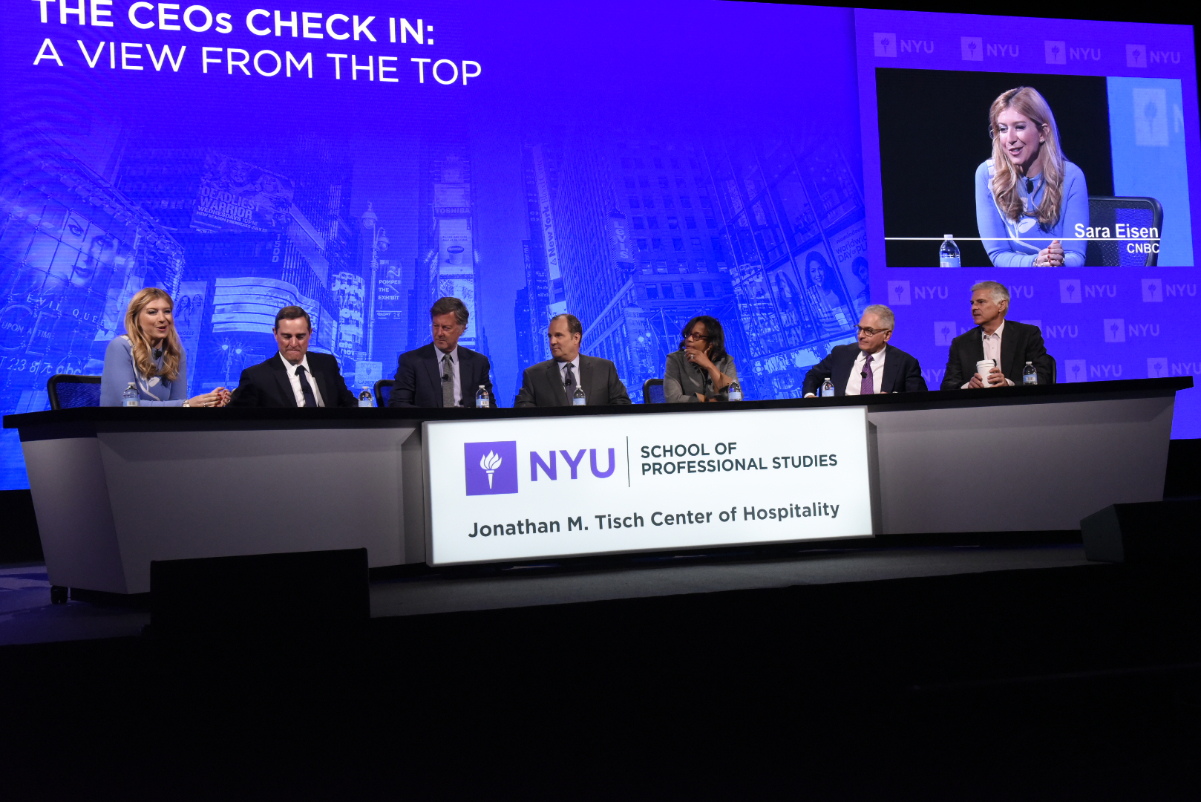Skift Take
The good times will keep rolling for the hotel sector, according to its CEOs. They make a compelling case.
Hotel bookings will continue to boom despite inflation. A lack of hotel construction is giving pricing power to existing hotels. At the same time, rising demand from corporate group events and international travelers from China and India are tailwinds supporting the sector.
That was the word on Monday from CEOs of the world’s largest hotel companies at the New York University International Hospitality Industry Investment Conference.
“The future has probably never been as strong as it is today,” said Sébastien Bazin, chairman and CEO of Accor, the largest hotel group based in Europe. “It’s stronger than pre-pandemic, though different in nature.”
Robust Hotel Pricing
Many travelers complain about today’s hotel prices, and sometimes with good reason.
“For the last six months, prices in Paris are 50% above 2019 levels. In London, 30% above,” Bazin said. “For 20 years we weren’t daring enough [in pricing].”
Yet the consensus of the executives was that, on average, hotels have just finally caught up with where pricing should be given supply and demand constraints and inflationary effects.
“For decades, owners were asking us about wanting to see more rate growth, and I think we’ve just caught up to where we should have been over time,” said Keith Barr, CEO of IHG Hotels & Resorts, which owns Holiday Inn and other brands.
Once inflation and the reversion to ordinary booking patterns materialize, pricing will seem less distorted, executives argued.
“For our investors, we forecasted our business’s progression between 2020 and 2027 and predicted a 3.5% compound annual growth rate in its average daily rate, said Mark Hoplamazian, president and CEO of Hyatt Hotels Corp. “It’s true on the short-term horizon we’re comparing to, it seems distended, but if you think about it over a longer period, hotel rates are not that outsized — especially given limited supply growth.”
Data supports the overall thesis. “In the U.S., the average daily rate on a real basis is a dollar off where we were in March 2019,” said Amanda Hite, president of STR, the leader in hotel performance benchmarking. “So for all the price growth we’ve seen, we aren’t back to where we were pre-pandemic, on average overall.”
The hotel sector has haves and have-nots. In the U.S. East Coast and Southeast cities are doing well. But cities like Seattle, Portland, San Francisco, and Minneapolis are incredibly weak.
Recession Won’t Crater Demand
As some leisure travelers pull back, group business planned ahead and on the books — though at a typically lower average daily rate — will likely support the hotel sector.
STR is forecasting a modest growth slowdown for U.S. hotels. This year, it predicts 5% growth in revenue per available room, a key industry metric. Next year, it predicts 4.6% growth.
“This year is the hardest year in my career that we’ve ever had to forecast, because when we look at every recession in the past, we saw a close correlation with a GDP [gross domestic product] decline leading to a decline in hotel demand,” said Amanda Hite, president of STR. “We’re breaking the norm from what’s happened in every other recession.”
Several factors have complicated forecasting.
“We’ve been living in Covid Bizarro World where the government pushed $10 trillion into the system,” said Christopher Nassetta, president and CEO of Hilton Worldwide. “But we’re going to get back, in the next 12 to 18 months, to the old world of fundamentals of supply and demand.”
Nassetta said that about 80% of Hilton’s business came from small and medium-sized enterprises, which have proven resilient travel spenders.
One of the fundamentals providing a tailwind to the hotel sector is that the supply of travel lodging hasn’t been keeping up with demand.
“The supply side is very, very attractive for our industry, with an expected 0.4% growth in supply in the United States this year,” Nassetta said. “I would argue that that is essentially zero because there’s a whole bunch of hotels that are basically becoming obsolete and that really don’t compete, and that’s about a half a point of supply.”
A lack of additional supply boosts the pricing power of existing hotels.
“The 30-year average [for hotel supply growth] is 2.5%,” Nassetta said. “It’s now much less than that. And that’s not going to change for the next two years … because of the unsettled nature of the regional banking system and a lengthening of the construction cycle.”
“Low supply is music to my ears,” said Leslie Hale, president and CEO RLJ Lodging Trust, a hotel-focused, real estate investment trust.

Asia’s Rebound
Another positive tailwind will be the emerging outbound travel demand from Asia Pacific.
Executives pointed out that Chinese outbound travelers still haven’t returned en masse. Executives argued that travelers will return as airlines add more flights.
“In April, crossborder airlift from China was only 40%, so still 60% capacity to go,” said Anthony Capuano, president and CEO of Marriott International.
Looking longer-term, Bazin was bullish on India as an outbound source market over the next decade, as an expanding middle-class increasingly ventures farther from home.
“If we get 10 to 40 million of them as additional outbound travelers, it’s a game changer for the industry,” Bazin said. “When you think about the power of the Chinese outbound travel, driven by the rising middle class’s wealth creation there, remember that India is going through that same evolution.”
But Bazin joked that the money would be spent serving them in hotels located elsewhere rather than building hotels in India’s cutthroat domestic market.
In the short-term, long visa application times for inbound markets, including India, are a headwind for hotels.
“The U.S. government needs to boost consulate staffing in many of the inbound markets,” said Geoff Ballotti, president and CEO at Wyndham Hotels & Resorts. “People want to come, but can’t get visas.”
A Few Headwinds
The U.S. hotel sector isn’t without problems, and labor is one of the biggest. Hotels are down at least 350,000 workers versus 2019 by the most conservative estimates quoted at the conference. The sector also has the highest quit rate of any U.S. industry, despite wages being up 29% from pre-pandemic levels.
Achieving net room growth has also become more challenging as new construction has nearly stalled. The major groups are affected differently, with some at 3% annual growth and others at 7%.
Adapting to technological change has also been a challenge for the hotel industry.
Packaged good providers know more about customers who spend two minutes looking at their product in the shopping aisle than hotel companies know about guests staying at their properties for days, said Omni Chairman Peter Strebel.
The hotel executives didn’t think the rise of generative artificial intelligence, as represented recently by ChatGPT, would cause much upheaval to the core of their businesses, which is human interaction. They cited examples of technology helping to improve back-office operations, such as setting rates and optimizing marketing expenditures.
“We went to ChatGPT and asked, ‘If Hyatt launched a brand like [its new Studios brand], what color should the brand be?'” Hoplamazian said. “It came back with a specific recommendation on [a shade of] blue. Our design agency came back with that identical color.”
Daily Lodging Report
Essential industry news for hospitality and lodging executives in North America and Asia-Pacific. Delivered daily to your inbox.
Have a confidential tip for Skift? Get in touch
Tags: ceos, future of lodging, hotel deals, hotel development
Photo credit: Mark Hoplamazian, president and CEO of Hyatt, gestures during a panel talk on June 5, 2023, at the New York University International Hospitality Industry Investment Conference. Source: Event organizers.
